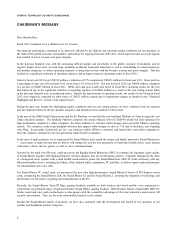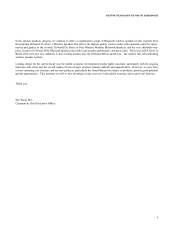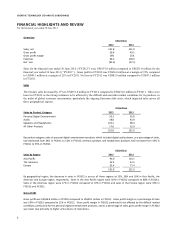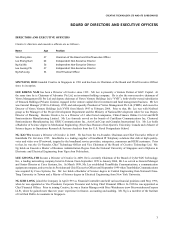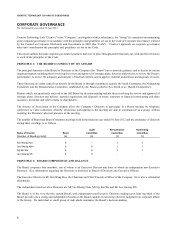Creative 2012 Annual Report Download - page 13
Download and view the complete annual report
Please find page 13 of the 2012 Creative annual report below. You can navigate through the pages in the report by either clicking on the pages listed below, or by using the keyword search tool below to find specific information within the annual report.11
CREATIVE TECHNOLOGY LTD AND ITS SUBSIDIARIES
None of the employees of the Group whose annual remuneration exceeds S$50,000 are immediate family members of the CEO
or any other Director of the Company.
Details of the Creative Employee Share Option Plans and Creative Performance Share Plan are set out in the Notes to the Financial
Statements.
PRINCIPLE 10: ACCOUNTABILITY
The Company provides shareholders with quarterly and annual nancial results of the Group within the regulatory reporting periods,
i.e. results for the rst 3 quarters are released to shareholders within 45 days of the end of each quarter whilst the annual results
are released within 60 days from the nancial year end. In presenting the Group’s annual and quarterly results, the Board aims
to provide shareholders with a balanced and understandable assessment of the Group’s performance and nancial position with a
commentary at the date of the announcement of the signicant trends and competitive conditions of the industry in which it operates.
The management provides all Directors with nancial updates of the Group’s performance, when required.
PRINCIPLE 11: AUDIT COMMITTEE
The Audit Committee (the “AC”) consists of three Directors, all of whom are independent non-Executive Directors. The Chairman
of the AC is Mr Lee Kheng Nam. The other two members are Mr Ng Kai Wa and Mr Lee Gwong-Yih. All members of the AC
have the appropriate accounting or relevant nancial expertise or experience.
The principal functions of the AC, among other matters, are:
• to review the quarterly and full year nancial statements to be issued by the Group with management and, where appropriate,
with the Company’s external auditors, before their submission to the Board;
• to review the scope and results of the audit and its cost-effectiveness and the independence and objectivity of the external
auditors;
• to review the effectiveness of the internal audit function;
• to make recommendations to the Board on the appointment, re-appointment and/or removal of external auditors, and to
approve the remuneration and terms of engagement of the external auditors; and
• to review interested person transactions.
The number of meetings convened by the AC is set out in Principle 1: The Board’s Conduct of its Affairs.
PRINCIPLE 12: INTERNAL CONTROLS
The Board acknowledges that it is responsible for the overall internal control framework, but recognises that no cost effective
internal control system will preclude all errors and irregularities, as such a system is designed to manage rather than eliminate
the risk of failure to achieve business objectives, and can provide only reasonable and not absolute assurance against material
misstatement or loss.
The AC, on behalf of the Board, has reviewed the effectiveness of the internal control system put in place by the Company and
is satised that there are adequate internal controls in the Company. The Directors regularly review the effectiveness of the
internal controls, including operational controls. Based on the internal controls established and maintained by the Group, work
performed by the internal and external auditors, and reviews performed by the management, various Board Committees and the
Board, the Audit Committee and the Board are of the opinion that the Group’s internal controls, addressing nancial, operational
and compliance risks, were adequate as at 30 June 2012.
The Company has in place a whistle-blowing procedure where staff of the Group can raise in condence concerns on possible
improprieties relating to accounting, nancial reporting, internal controls and auditing matters. Under these procedures, arrangements
are in place for independent investigation of such matters raised and for appropriate follow up action to be taken.



